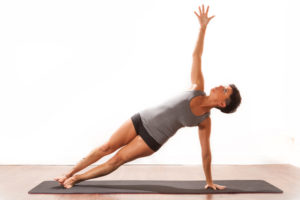Can Planking Cure Scoliosis?
A 2 year old study has lead to some internet buzz about an “Ancient Therapy” that can improve your scoliosis.
So what is this ancient therapy that holds the promise to at least alleviating your scoliosis? One study demonstrated that for the six million people in the United States who suffer with scoliosis, performing a basic yoga pose for just a few minutes a day can dramatically improve spinal distortions.

According to this study the spinal curvature of scoliosis patients was reduced by about 50% when they practiced a yoga pose known as Vasisthasana. This position is also known as a “side plank.” Researchers were amazed to observe that scoliosis patients who employed this pose on the curved side can strengthen muscles in the lower back, abdomen and spine which allows the spine to straighten. This suggests patients who practice this side plank pose regularly may not need scoliosis bracing (the usual therapy for scoliosis) or scoliosis surgery.
The results of this simple yoga physical therapy were shocking. The x-rays, which were taken before the study was conducted, when compared with those taken 3 to 22 months later showed fairly dramatic improvement of the spinal curvature.
According the report, after 6.8 months of follow-up, spinal curving decreased by an average of 41% in 19 of the subjects who practiced the poses daily. The average improvement in the group was 32%.
If it sounds too good to be true…
Unfortunately upon closer inspection of the study, some very serious flaws show up. The amazing thing is how much press this study got in spite of VERY POOR QUALITY RESEARCH.
OK, let’s review some of the flaws and then let’s talk about the positive side of the study.
- Too small a sample size to be meaningful. Only 19 compliant subjects! A study of this nature should have about 200 to provide meaningful results.
- The recommendations are opposite to the exact same pose as taught by Schroth technique!
- There was no consistency in the participants included in the study. They ranged from 7 teenagers with scoliosis to 12 adults with degenerative scoliosis. This variety in the small sample size can provide very misleading data.
- Curve sizes ranged from 6 degrees to 120 degrees! Below 10 degrees, we don’t even diagnose as scoliosis!
- The greatest curve improvement was seen in participants with curve sizes greater than 40 degrees. Only one of the AIS patients had a curve greater than 40 degrees.
While it is tempting to say that with such a small samples size, it is possible to get a positive outcome by accident… (Remember the quote, Lies, Damned Lies and Statistics) we still see that there was improvement in the patients…
Why did the side plank work?
Upon looking at the data, it appears that the majority of those who exhibited improvement were the older patients with the larger curve sizes.
My theory on the improvement is simply that these subjects were now exercising! Yes, that’s it. They were actively exercising their core muscles. The research design also instructed the patients in how to hold their particular scoliosis in a more balanced position. In fact, the researchers used different configurations of the side plank. There were 7 different variations of the plank used in the study.

The concern with studies like these is not just that the research practices behind them are questionable but how the results are shared with the public. A small experiment with 19 participants who have varying types of scoliosis becomes “Cure Adolescent Idiopathic Scoliosis with ONE Simple Move!’ or “Research Shows Planking Reduces Scoliosis by 50%!”. As we’ve seen with Inversion, KKT and other supplemental exercises and therapies, it becomes the reader’s responsibility to review the research for a more accurate interpretation. With approximately 2-3% of the world’s population diagnosed with scoliosis in one form or another, there is an overwhelming desire for answers and quick-fix solutions. Unfortunately, research like this is all too easy to spin into clickbait fodder.
Let’s recap here.
The majority of subjects had degenerative scoliosis.
Various forms of the plank were used depending on the shape of the scoliosis for each participant.
Exercise IS proven to be a therapy for scoliosis, BUT… each patient must have a custom designed scoliosis exercise program. Because everyone’s scoliosis is different and we develop scoliosis for different reasons, it’s important that treatments address these differences. Scoliosis is a complex disorder and there doesn’t seem to be a simple solution on the horizon.
Outside of a custom designed treatment program, exercise is always important for EVERYONE and yoga can be a fun and therapeutic tool for scoliosis patients. For more information on yoga for scoliosis, here are some articles to get you started and avoid making your scoliosis worse:
Yoga for Scoliosis – A Comprehensive Overview
Yoga for Scoliosis – Which Poses Help?
Yoga for Scoliosis – Moves to Avoid
To a better spine,
Dr. Andrew Strauss